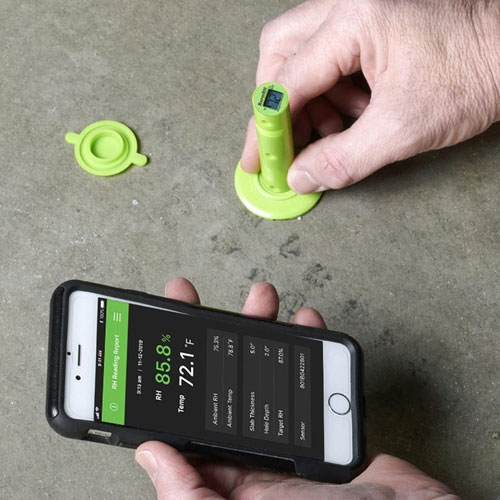Why Knowing About Concrete Drying Trend Analysis Matters
Hint: It Will Make Your Job Easier
Arguably one of the biggest obstacles for sticking to your construction schedule is the concrete drying time. If you feel like it takes forever, you’re not alone.

The best tool for concrete drying trend analysis is the Rapid RH L6 system by Wagner Meters.
Because of all the variables that affect concrete drying time, it can be almost impossible to predict an accurate drying time. But when you use a trend analysis for your concrete, you are more equipped to make scheduling decisions.
If you’re tired of wrong estimates, then this is what you need on your job site.
Why guestimating isn’t the best option
An estimate isn’t based on any scientific facts.
Even the rule of thumb, “it takes one month for each inch of thickness to dry” isn’t reliable. Why? Because of all the variables we mentioned above. Here are a few:
- Type of concrete
- Weather conditions
- Proximity to outside walls
Different types of concrete have different water-to-cement ratios. Concrete with a higher initial water content will take longer to dry.
Even with weather conditions, there are multiple variables to consider. Is it in a dry or humid climate? How much sunlight does the slab see on a daily/monthly basis? Those two factors alone have a huge impact on the drying time of concrete.
Since you likely don’t have much control over those variables, it’s safe to say that concrete drying time is just too unpredictable. This is why pure estimation of drying time almost always results in schedule delays or failed flooring installations.
Instead, we recommend using a more scientific method: trend analysis.
How to use trend analysis
As soon as the concrete is ready and the environment is enclosed with a running HVAC, start taking moisture readings and keep a thorough record of your findings. That way, based on the data, you can make more accurate scheduling decisions sooner.
The ASTM F2170 standard says to use in situ probes for moisture testing. And the guidelines require using 3 concrete moisture sensors for the first 1,000 square feet. For each additional 1,000 square feet of concrete area, use another sensor. So, if your slab is 5,000 square feet, you’d need 7 sensors.
Typically, if you are going to monitor and assess drying trends in the slab early, the recommendation would be to install a portion of the required tests early and then install the remainder of the tests closer to the actual finish installation.
In addition to the moisture testing of the slab, you’ll want to keep track of the ambient conditions.
A combination of the data from the slab and the ambient conditions gives you what you need to perform the drying trend analysis. You can map out your data on a chart and be able to better understand when the slab will be dry enough to move to the next step.
Here’s the best tool to use for trend analysis
The Rapid RH® L6 system is the best tool for the job, hands down.
The relative humidity (RH) test method produces results faster than any other testing method. No more waiting 72 hours. Now you can get your readings in 24 hours. The Rapid RH L6 system is ASTM F2170 compliant and gives you the best in situ probe on the market.
And to take data recording to the next level, add the DataGrabber® to your toolkit.
With your readings already uploaded to the DataMaster™ L6 app on your smart device, the DataGrabber can be programmed to get automated readings at set intervals. This makes it almost too easy to do trend analysis. It’s the perfect addition to the Rapid RH L6 testing system because it makes data logging easier and more efficient than ever.
Previously published in Tomorrow’s Contract Floors
Jason has 20+ years’ experience in sales and sales management in a spectrum of industries and has successfully launched a variety of products to the market, including the original Rapid RH® concrete moisture tests. He currently works with Wagner Meters as our Rapid RH® product sales manager.
Related Posts via Taxonomies
Last updated on May 31st, 2022



